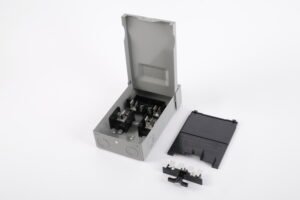In HVAC systems, the A/C Disconnect Box is an important safety device. It disconnects the power to the air conditioning unit, protecting both the equipment and the people working on it.
When choosing an A/C Disconnect Box, one of the key factors is whether it includes a fuse. A fuse helps protect the equipment from overloads and short circuits. The decision to use a fuse-equipped or non-fuse disconnect box depends on the needs of your specific project.
This article will explain the key differences between fuse and non-fuse disconnect boxes for A/C units. It will cover their best uses and the advantages and disadvantages of each type.
1. Fuse-Equipped A/C Disconnect Box
1.1 Function and Advantages
A fuse-equipped A/C Disconnect Box includes a fuse that will blow when there is an overload or short circuit. This cuts off the power and prevents damage to the air conditioning system and the electrical wiring.
The key benefit of this box is the added protection it offers. It is very helpful when the electrical current is too high or if equipment breaks down. This helps prevent fires and other damage.

1.2 Best Applications
- Large Commercial or Industrial HVAC Systems: These systems handle large electrical loads and have a higher risk of electrical problems. A fuse-equipped disconnect for A/C will disconnect power if an overload happens, keeping both the system and people safe.
- Industrial Environments: In factories or warehouses, HVAC systems often run under heavy loads. The risk of overloads or faults is higher. The fuse provides extra protection against damage or fires.
- High-Risk Areas: In places like chemical storage areas or zones with explosive gases, fuse-equipped disconnect boxes help reduce the risk of fire or explosion due to electrical faults.
- Projects That Need to Meet Safety Standards: For projects that require UL certification or meet National Electrical Code (NEC) standards, fuse-equipped disconnect boxes help ensure compliance with safety regulations.
1.3 Disadvantages
- Need for Fuse Replacement: When the fuse blows, it needs to be replaced. This adds to maintenance costs and downtime for the system.
- Inconvenience: Some projects need low-maintenance systems. The need to replace fuses can be a hassle in these cases.
2. Non-Fuse A/C Disconnect Box
2.1 Function and Advantages
A non-fuse A/C Disconnect Box does not include a fuse. Instead, it simply disconnects the power without offering additional protection from overloads or short circuits. This type of box is simpler and cheaper to install. It is ideal for HVAC systems that have lower electrical loads and a lower risk of electrical faults.

2.2 Best Applications:
- Small Residential HVAC Systems: These systems usually do not have high electrical loads, so the risk of overloads is low. A non-fuse disconnect box is enough for these systems, and it keeps installation costs down. Most home HVAC units already have internal protection (such as circuit breakers).
- Small Commercial Projects: Small businesses or offices with HVAC systems that don’t use much power can use non-fuse disconnect boxes for A/C units to save on costs. These systems typically have little risk of electrical faults.
- Systems with Built-In Protection: If the air conditioning unit has internal protection, such as a circuit breaker, a non-fuse disconnect box can be used. This avoids unnecessary costs and complexity.
- Low-Risk Areas: In places where the electrical load is low and the risk of faults is minimal (such as in most residential or office settings), a non-fuse disconnect box is suitable.
2.3 Disadvantages:
- Lack of Overload Protection: Without a fuse, the system is at risk of damage if an overload or short circuit happens. This can lead to expensive repairs or even system failure.
- Higher Risk of Damage: If a fault occurs, the lack of fuse protection means that the system won’t shut down quickly enough to prevent damage to the unit or wiring. This could result in fire or equipment damage.
- Possible Compliance Issues: Some projects may require strict safety standards (like UL or NEC regulations). A non-fuse disconnect box might not meet these requirements.
3. Summary and Recommendations
| Feature | Fuse-Equipped A/C Disconnect Box | Non-Fuse A/C Disconnect Box |
| Applicable Systems | Large commercial or industrial HVAC systems | Small residential or commercial HVAC systems |
| Protection | Provides overload and short circuit protection, preventing equipment damage and fire risks | No additional overload or short circuit protection, just disconnects power |
| Installation Complexity | More complex installation, requires regular fuse replacement | Simple installation, lower maintenance costs |
| Suitable Environments | High-risk areas (e.g., chemical storage, explosive gas zones) | Low-risk environments (e.g., residential or small commercial projects) |
| Compliance with Safety Standards | Meets UL certification, NEC, and other electrical safety standards | May not meet certain strict electrical safety standards |
| Maintenance Requirements | Requires regular fuse checks and replacements, adding maintenance cost | No need for fuse replacement, lower maintenance cost |
| Cost | Higher cost, suitable for larger systems or high-risk projects | Lower cost, suitable for small systems or low-risk environments |

